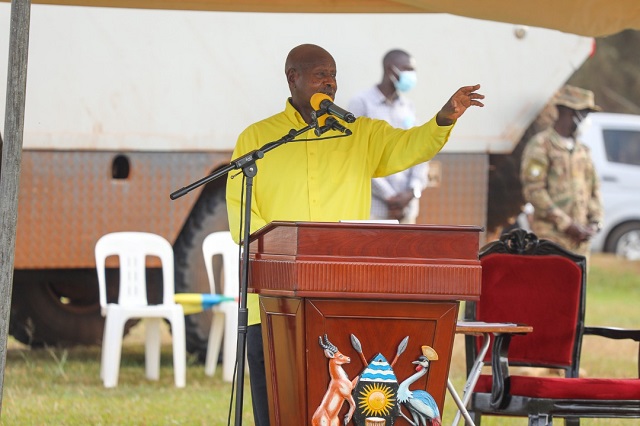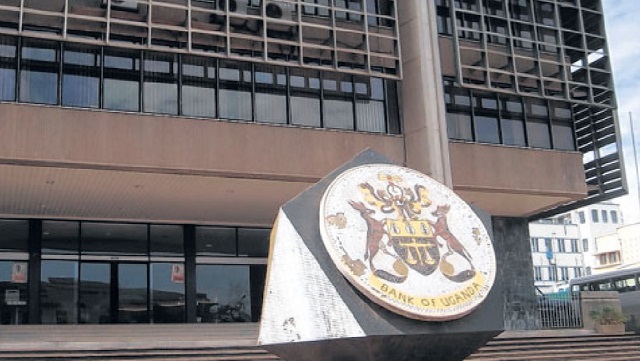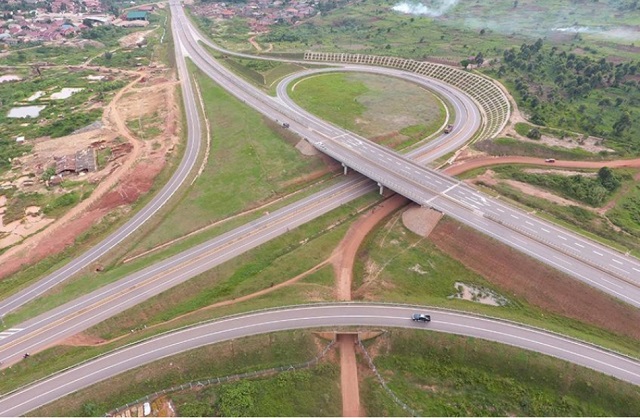
Why his stabilising the political dispensation and sustaining economic growth is important
THE LAST WORD | ANDREW M. MWENDA | On January 26, President Yoweri Museveni and NRM will mark 36 years in power. His is third longest serving presidency in Africa today, and one of the longest in the post-World War Two world. What is his legacy?
Given Uganda’s (and Africa’s) post-independence history, I would suggest two: stabilisation of the political dispensation and putting and sustaining the economy on the rails of growth for over three decades.
When he came to power, Museveni’s became the eighth presidency in Uganda since independence. This means each of our presidents had served on average 2.87 years. All these transitions were characterised by chronic instability and violence. By giving Uganda a very long period of political continuity and stability, Museveni helped resolve the biggest source of state fragility that had led Uganda to state failure. As a result, Uganda today, previously a chronically unstable failed state, plays the most critical stabilising role this region, helping prop such countries as Somalia, Central Africa Republic, South Sudan and DR Congo.
Yet this article will focus on the second pillar of Museveni’s legacy – sustained economic growth over the last 36 years. I focus on it because it is the least appreciated of Museveni’s contribution to Uganda.
Part of the problem is that many people misunderstand the process of economic development. Some think economic growth doesn’t matter. Economic growth matters because it is the foundation for economic development. In fact, economic development is economic growth over a very long period of time – usually generations. Why? Because growth is possible over the long term only through technological change i.e., innovation.
Secondly others think it is easy to sustain economic growth even at very high rates. Yet this is an illusion. Many governments across the world have been able to initiate growth and run a good sprint. However, very few have been able to sustain it over a very long period of time i.e., run a marathon.
Very high rates of growth for a few years are followed by periods of slow, stagnant or even negative growth. As a result, previous gains are significantly undercut. Therefore, the biggest challenge of economic management is not initiating economic growth per se, but sustaining it over generations.
According to data from the IMF, between 1986 and 2020 (35 years), Uganda sustained an average annual GDP growth rate of 6%. This makes it the 11th fastest growth economy in the world, out of 199 countries; 4th in Africa behind Equatorial Guinea, Ethiopia and Mozambique. Equatorial Guinea is number one in the world but this is entirely due to an oil bonanza; a gift of nature or God, not a result of good policy.

Uganda’s growth is the more remarkable because it is a landlocked country, has had no rich minerals, some of it neighbours have been politically unstable countries and the country was embroiled in civil wars between 1986 and 2005.
In fact, when you examine data, there is not a single short-term block-period of say five or ten years when Uganda’s economic performance is among the best 25 countries in the world.
During the first five years of the Museveni administration (1986-90 when most people think the president was doing best) Uganda was the 40th fastest growing economy in the world. In the first ten years (1986-95), it was the 28th fastest growing economy in the world. Even when we come to the last five years (2016-2020), Uganda was the 27th fastest growing economy in the world; in the last ten years (2011-2020) it was the 33rd fastest growing economy in the world.
It is only when we stretch the time to 30 or 35 years that Uganda’s economic growth rate comes among the top 13. Why is this important? Because it demonstrates the point above – that economic development is a marathon, not a sprint. The winners are those who sustain growth over generations and the Museveni administration has proven itself very good at this.
Uganda has been able to sustain long term growth in large part because of policy innovation, policy consistence and sound management of policy. This assures investors that their investments are safe i.e., will not be subjected to the uncertainty of regular policy reversals.
For many people, Uganda’s average real growth rate 6% over 35 years seems low. This is especially so when you compare with China which has done 9%. For instance, a difference of 3% in growth rates over 40 years makes a huge difference. But China is an outlier. Next to it is Bhutan which has done 7% (3rd) and Ethiopia 6.73 (4th) where the difference of 1% while big (especially if compounded over decades) is not fundamentally different. Therefore, Uganda under Museveni is a global star in growth.
Why is this important? Economists and statisticians use the Rule of 72. This rule says that if anything under measurement grew at an annual average of 1%, it would double every 72 years while if it grew at an annual average rate of 7%, it will double every ten years.
In his great book, The Next Convergence, the Nobel laureate in economics, Michael Spence, shows that between 1955 and 2005, only 13 countries in the world sustained average economic growth at 7% and above during any block period of 30 years. When I checked Uganda’s 30-year average (1986-2015), it was 6.74%. Impressive!
Given a population growth rate of 3%, per capita income growth between 1986 and 2015 has been 3.5%. No European country has achieved this except West Germany between 1950 and 1980.
Again, one may think 3.5% per capita growth is small. But it is actually highly impressive by historic standards. For instance, the USA has a nominal per capita GDP of $69,000 today, the 9th highest in the world. Now look at this: according to Thomas Piketty in his majestic book, Capital, over the last 100 years, the USA has sustained a per capita GDP growth of only 1.5%, Europe 1.45%. The nations of East Asia (China, Singapore, Hong Kong, South Korea and Taiwan) have been unique in the history of economic growth because their per capita GDP growth has averaged more than 5% over 40 years.

Uganda’s GDP in 1986 is quoted in official statistics at $5 billion (or $12.72 billion in 2022 prices). Yet this is misleading because at that time the exchange rate was distorted, having been fixed by the state. That is why, when it was liberalised in 1992, GDP fell to 2.7 billion (or $5.4 billion in 2022 prices) in spite of average growth of 6.6% over the same period. Equally per capita GDP in 1986 was quoted at $400 yet in spite of growth it fell to $160 in 1992. Calculating backwards, our per capita income in 1986 was $142 (or $340 in 2022 prices). Today it is $1,018. Therefore, over the last 35 years, Uganda’s GDP has grown eightfold in real terms while per capita income has grown threefold over the same period.
Now some people deride GDP as a measure of economic success. Indeed, many arguments they raise about its weaknesses and distortions are valid. Yet in spite of this, mankind has not designed any index to act as a proxy for economic success that is better than GDP.
Bhutan innovated the Gross National Happiness (GNH), Maryland the Genuine Progress Index (GPI) and UN, the Human Development Index (HDI) etc.
There are many problems with these indexes and I have no space to enter that debate here. Simply put, no country with a per capita GDP of $600 has the vast majority of its people living a good life i.e. are able to meet many of the essential necessities of life. Equally, no country with per capita GDP of $60,000 has the majority of its people living in misery.
In any case, indexes are self-referential. They send signals of what you want to send. You load them up with what you think is important and the index tells you how you are doing. For instance, Scandinavian countries regularly come on top of the HDI. But this is because the HDI is, at its heart, really a measure of how Scandinavian a country is.
Thus, in the search for a replacement for, or useful addition to, GDP, it is vital to acknowledge this basic problem with composite indexes. Perhaps the Canadian Index for Wellbeing (CIW) is better because it asks people what makes their lives happy.
Uganda can develop her own index. Reading traditional and social media, I get the sense that most Ugandans want jobs, better public goods and services (good roads, clean water, access to electricity, good schools and hospitals etc.). All these are only possible if the country has money to pay for them. The source of jobs is often (not always) sustained growth and so is the source of state revenues to pay for public goods and services. Even abstract aspirations like freedom, dignity and self-actualization are more likely to be largely (not entirely) a result of increasing income which gives people access to opportunities to make choices.
In 1986, Ugandans had access to one television station (in only five towns), one radio station, one university, two brands of soda, two brands of beer, etc. And even these were not always available.
Today there are hundreds of televisions and radio stations, tens of universities, and supermarkets and shops (even in the remotest parts of the country) are fully stocked with a large variety of essential and non-essential goods. This variety of choice is an essential indicator of economic development. To be poor is to have little choice available and this increase in possibility is the most important aspect of escape from poverty.
Museveni always says that in 1986, Uganda collected Shs5 billion in revenues. That is Shs33 billion when adjusted to 2017 prices – giving us per capita revenue of Shs2,200.
Today, URA collects Shs60 billion per day – that is per capita revenue of Shs540,000. Few countries have witnessed this rapid growth in revenue. Even when I shifted the base year to 1992 (to remove the distortions created by civil war), Uganda’s revenue growth performance was better than Kenya, Tanzania, Zambia, Malawi, Benin, Senegal, Ghana and Nigeria. Only Rwanda and Ethiopia did better. None of the rich nations of Europe and North America could even compete. The problem is that the country began on a very low base.
Refer to the Rule of 72 again. If the per capita income of Uganda had grown at the 7% per annum, the highest ever recorded in history it would double every ten years. Therefore, this year it would be $1700, demonstrating that transformative change in income takes generations. This would still be far below that of Kenya today at $2,200.
But Uganda’s per capita GDP has grown at 3.5% and therefore could only double every 20 years, hence its current value of $1,018. And yet this is among the highest rates recorded in history outside of East Asian tigers.
So, when we feel frustrated by less change in incomes, it is not because NRM has performed poorly but because economic transformation takes generations. Yet in spite of our justified frustrations, economic growth has led to growth in private incomes and state revenues.
Growth in private incomes has made it possible for many of our citizens to improve their lives by living in better houses, dressing better, eating better and accessing other essential and nonessential goods and services that make modern living comfortable.
No wonder life expectancy has improved from 39 to 65 years, the number of people living in poverty has reduced from 56% in 1992 to 20%. Growth has also led to 60% of Ugandans having access to electricity (22% on grid and 38% on solar), up from 1% in 1986.
Conversely growth in state revenues has improved the capacity of the government to serve our citizens better through the supply of public goods and services. Today, every border of Uganda with her neighbours is connected by a paved road. Up to 80% of the population has access to an improved water source. The country is largely secure and one of our vital exports to our struggling neighbours in this region is security. This is a great transformation given that 40 years ago, Uganda was insecure and exporting refugees to her neighbours and now is a big host of refugees.
The lesson to draw from this tour is that economic growth is primary, the rest is derivative. It is better to seek growth and then discuss growing income inequality in the context of a growing economy, not a stagnating one. This is because ultimately, for anyone, it is better to hold a small slice of a growing pie than to hold a large slice of a shrinking one.
****
 The Independent Uganda: You get the Truth we Pay the Price
The Independent Uganda: You get the Truth we Pay the Price






Mwenda Mwenda Mwenda….. sometimes I think that you think you’re talking to fools…..or, that once you repeatedly tout a lie and you come to believe it’s true then it is true…..non of the things you state here even Museveni would believe you…. you didn’t not pursue the line of sustainable political dispensation because you couldn’t run away with it. The only sustainable political dispensation we have witnessed is of the Museveni project and its longevity lasts as long as Museveni is alive.
Two. The things you say about the Ugandan economy are self contradictory….. and I won’t use the huge figures and the sophisticated economic words you so apply but rather an elementary description of true economics….. you state that the Ugandan economy has experienced an exponential growth over the years and using the 72 rule, Uganda should be able to double it’s GDP for every 20years. Let’s assume Uganda was a person and in 1986 Uganda was earning 500s shillings per day. This will mean that Uganda can only afford a chapati for a meal per day. But over time (after 36 years), Uganda earns 25 times the amount it earned in 1986…. meaning Uganda is earning 12,500 shillings per day. This would be transformational. It will mean that Uganda can afford 3 meals of 500 shillings per day and remain with a balance of 11,000. It also means that Uganda if the only activity was to eat, can save 330,000/= per month…. which means, he/she can afford to rent a house of 100,000/= access medical services of 50,000, pay for electricity of 20,000 and water of 20,000 and have a balance of 140,000/= pee month. This is the transformation I am highlighting. However, over the years, Uganda has largely abdicated from its formal duties….apart from upe and shells of health centres, Uganda has sold off most of its parastatals and yet it continues to borrow to perform its core duties including infrastructure. How do you explain that? Our GDP ratio to debt has surpassed the worrying threshold of 49%. You state that the poverty has reduced from 63% to 20% but in the recent findings of Bank of Uganda 39% were regarded to be outside Uganda’s money economy. From the year 2010 to 2016 Uganda’s real GDP stood at 2%. Since 2019, Uganda’s economy has been growing at 1.3% don’t these years factor in your 72 rule? If we’re growing by what you state, why is it that agriculture has remained the dominant factor of our economy…it contributes 25% of our GDP, 50% of our exports and 70% of employment? Lastly, I watched your exchange you had with ofwono opondo on TV. You claimed that government had handed over the economy to foreigners and your reference was the banking sector. Maybe we’re running a foreign economy that has no local business attachment?
Thanks
Rajab with such great response to Mwenda. I will say nothing more. you said it well.
That’s Andrew Mwenda for you, always pandering to Museveni’s whims coz his pay packet depends on embellishing stories about his boss’s protracted thirty-five-year(and soon to be forty) misrule.
Thank you for the brilliant and timely response!👏
Mwenda I think ur too kla or urban entered and probably too academic with many of ur writings. Get time and traverse this country especially villages and see if some of these things u write are correct. I hv heard the chance to travel to some of our villages I can confident give a first had experience. Pple are extremely poor to the point of hopelessness. The secondary road network is in shambles, schools are in a sorry state, hospitals/healthy centre’s hv no/absentee doctors/health care providers. It’s terrible. Go to, especially, to the north and east and see some of these things am talking about for urself.
Yes, NRM has done fairly well but at 36years, they could hv done much, much better.
Let’s be honest, we are still a third world country no doubt.
.
Unless Uganda North of the Nile is not part of Uganda, where was Mwenda when for 25 years there was mass instability and internal displacement in Greater Northern Uganda?
If Andrew is being honest with himself and Ugandans, where did the 25-year armed conflict, widespread ignorance, poverty and diseases in Greater Northern Uganda fit in Mwenda’s “sustain long term growth in large part because of policy innovation, policy consistence and sound management of policy.”?
Inspire of all the glowing reports from the academic quarters, for me it is the paucity of tangible achievements that comes to mind as I watch a hawker selling Kenyan salt at scandalized railway crossing in kasese. As if to mock the revolution is a derelict salt processing factory built by an old dictator in 1978/on the shores f lake Edward about 30km away!
And as sure as night follows day these issues will be top on the agenda towards the 2026/elections and of course salt from Kenya will be used as facilitation and Museveni will give his usual speeches and take the day.
For the phrase singers I think some more practical issues should be handled .I actually all along been waiting for the lLast Word to split the failure of the Sembule empire which had earlier on been dissected by t the Uganda Confidential when its celebrated editor had the ear of those that matter.
Thank you.
Wama ugandans twewagirire mzee MUSEVENI YAJJA Kununura ffe okubeera muddembe nga bwetukola egyafe nga teli atugobaganya. ekizibu kya bana uganda tetusiima kyetuyiina. GEN.MUSEVENI Yaletebwa KATONDA yensonga rwaaki afugidde ebbanga panvu. Mumuleke mukole ebyabatondedwa. Muna uganda agire ngalina kudembe
Basing on facts you have gathered your correct!
But does it apply equally in the hands of all ugandans?
What you have to understand is ugandans are too poor to an extent of failing to have a meal for a day.
If we turned the assets you have today can finance 5 districts to an extent leaving you an shaken. This is what makes you think all ugandans are balanced
There’s is no doubt at least security has been achieved and at least balanced for the past 20yrs.
Banaange ugandans tetuusiima, sibulimuntu nti afuga egwaanga, Kino kiba kitone okuva ewa KATONDA. Ekisooka kumpi 60% temwaalaba kumbeera eyaaliwo before GEN.MUSEVENI! musabe Nyo nyo GEN.MUSEVENI Awaangaale, naye kalisalawo nti ebyobufuzi abiwumudde, lwemulimunoonya, muwoza nti mukooye , mwaligambye nti MUKAMA Yongela president wafe obuwaangaazi…
omulala yaansesa, mbu UGANDANS BAKOOYE OKUBEELA NE PRESIDENT OMURUUNGI, MBU BEETAAGAMU OMUFUZI NGA BALI ABEEMABEGA, KOONZE NAMUDAMU NTI BYOYAGALA KATONDA YABITUTAASA 1986.
Yes, Ugandan economy has grown but it is inappropriately rationalized by AM. The figures are as misleading as they are contradicting. It is always easy for AM to to draw conclusions a posteriori, analyze and interpret current events, label them and conclude that they have connections with any historical account. This is the reality: just like every human being, AM reasoning is limited to only things he can ably see and correctly analyze. The true is that Uganda’s growth account is a product of many factors, some unintentional and beyond prediction. Chief among these factors is the resilience and adaptability of her people…….to be continued